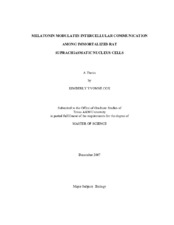| dc.description.abstract | The mammalian brain contains a regulatory center in the diencephalic region known as
the hypothalamus that plays a critical role in physiological homeostasis, and contains a
variety of centers for behavioral drives, such as hunger and thirst. Located deep within
the hypothalamus is the suprachiasmatic nucleus (SCN), or the master biological clock,
that organizes rhythmic physiology and behavior, such that critical events take place at
the most appropriate time of the day or night and in the most appropriate temporal, phase
relationships. Cell-to-cell communication is essential for conveying inputs to and
outputs from the SCN. The goal of the present study was to use an immortalized neural
cell line (SCN2.2), derived from the presumptive anlage of the rat suprachiasmatic
nucleus, as an in vitro model system to study intercellular communication among SCN
cells. I tested whether the pineal neurohormone melatonin could modulate cell-to-cell
signaling, via both dye coupling (gap junctional communication) and calcium waves
(ATP-dependent gliotransmission). I also tested whether extracellular ATP could
influence the spread of calcium waves in SCN2.2 cells. Lastly, the ability of
extracellular ATP to modulate SCN physiological responses to melatonin in SCN2.2
cells was examined.
I show that melatonin at a physiological concentration (nM) reduced dye
coupling (gap junctional communication) in SCN2.2 cells, as determined by a scrape
loading procedure employing the fluorescent dye lucifer yellow. Melatonin caused a
significant reduction in the spread of calcium waves in cycling SCN2.2 cultures as
determined by ratiometric calcium imaging with Fura-2 AM, a calcium sensitive
indicator dye. This reduction was greatest when an endogenous circadian rhythm in extracellular ATP accumulation, determined by luciferase assay, was at its trough or
lowest extracellular concentration. In addition, melatonin and ATP interacted in the
regulation of gliotransmission (calcium waves), and this interaction was also specific to
particular phases of the endogenous SCN physiological rhythmicity. Thus, I have
established that a complex interaction exists between established melatonin signaling
pathways and this newly discovered ATP accumulation rhythm, with the mechanisms
underlying this relationship linked to endogenous cycling of SCN cellular physiology. | en |


